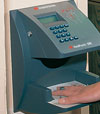

Retailers are recognising the importance of sophisticated biometric technology for identification and verification.
Protecting people, property and product is an ongoing responsibility for retail managers; whereas accurate time and attendance recording increases the retailer's ultimate workforce profitability. Biometric applications are used throughout the retail sector - from supermarkets to restaurants to fast-food franchise operations.
In retail
A supermarket chain with 1300 employees installed IR Recognition Systems' Biometric HandPunch terminals at its stores. The reader automatically takes a three-dimensional reading of the size and shape of a hand and verifies the user's identity in less than one second. Biometric readers eliminate the need for employees to carry a badge, thus eliminating the problem of lost or forgotten badges, and provide more accurate information about who is working and when.
"The supermarket chain was looking for a solution that would eliminate 'buddy punching,' the practice of employees clocking in and out for each other," says Raymond Noppe, managing director of Uniclox Technologies. "They additionally needed a system that would reduce the need to manually record workers' hours when the badges were forgotten, damaged or lost."
Although the supermarket chain first considered fingerprint technology, the fingerprint readers were unable to verify users with damaged, dirty or dry fingerprints. They also discovered that they had to keep the fingerprint sensor clear and clean or it would perform poorly or not at all in the greengrocer, meat and fish departments.
"HandPunch biometric readers handle demanding environments and increasing user volumes with ease while providing impeccable reliability," continues Noppe.
The supermarket chain uses a total of 14 of these biometric hand readers in its six branches.
In restaurants
The effectiveness of the hand readers is further demonstrated in the restaurant business where a solution for a costly payroll problem was needed for a restaurant with 280 employees. The badge and time clock system made it easy for employees to 'buddy punch' - clock in others who were late or clock out friends after the shift ends, earning them overtime pay.
The main need of the restaurant was to stop buddy punching and improve the accuracy of timekeeping. The restaurant wanted a fraud-proof timekeeping system that integrated seamlessly with time and attendance software and a payroll system.
Two HandPunch hand readers were installed as the hand readers eliminate the expenses associated with employee badges as well as fraud caused by buddy punching. Instead of filling out or punching timecards, restaurant employees simply place their hands on the readers and the user's identity is verified.
The HandPunch terminals connect over a computer network to human resource management software that tracks time and attendance. The human resource department receives the actual hours clocked by the terminals and the software exports time files directly to a local payroll service, which eliminates manual payroll entry.
This process resulted in a seamless, quick and efficient payroll and no resistance was encountered from employees.
A fast-food franchise with 3400 employees at 85 outlets cut payroll costs by up to 22% annually after incorporating HandPunch biometric terminals to record time and attendance. On average, this particular system generates over 7500 transactions daily, resulting in over 2,5 million 'punches' annually.
Students and temporary staff make up about 90% of the franchise's workforce and they were frequently punching one another in to cover for exams or other personal events - hence the need for identifying and verifying employees. Most supervisors in the franchise group are promoted from within and many find it difficult to impose rules and restrictions on fellow workers.
"A card only verifies a card," emphasises Noppe. "Finger scanning is used for other applications, but we believe that hand geometry is more effective and produces fewer errors when there are larger employee populations. With hand geometry, a larger area is scanned than with finger scans and the template is updated after every scan so it remains current."
Supervisors at each franchise use the terminals to authorise and verify employee time and overtime on a computer located at the store. Instead of filling out or punching timecards, employees simply place their hands on the reader to verify each employee's identity. The hours are then sent to a central payroll processing centre by modem.
The fast-food franchise is recouping significant payroll expenses with the biometric terminals. Their employees like the system because their payroll information is processed quickly and without mistakes; and, they receive regular reports with information about their time and attendance.
For more information contact Raymond Noppe, Uniclox Technologies, +27 (0)11 439 2000, [email protected].
| Tel: | +27 11 439 2000 |
| Email: | [email protected] |
| www: | www.uniclox.co.za |
| Articles: | More information and articles about Uniclox |

© Technews Publishing (Pty) Ltd. | All Rights Reserved.